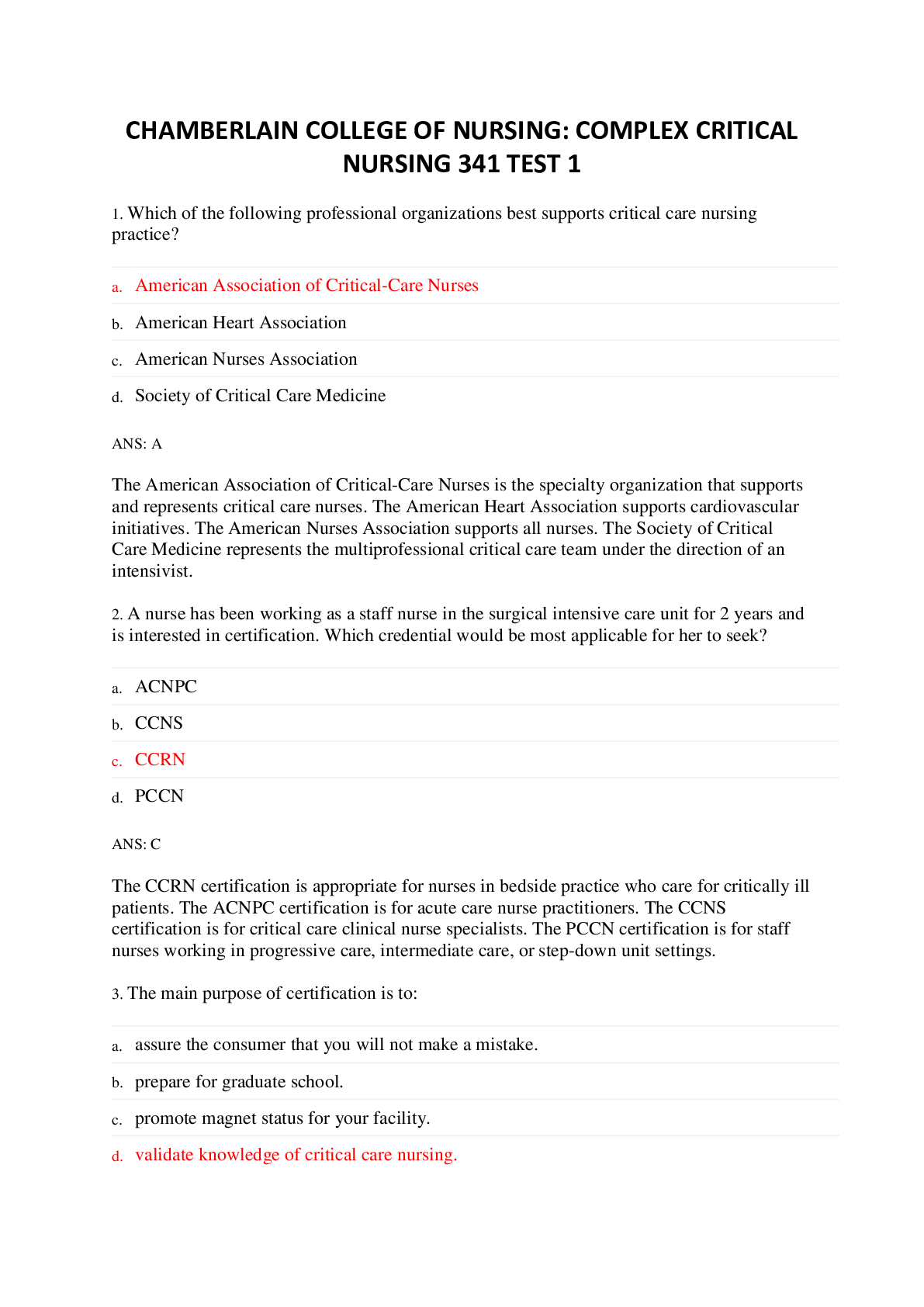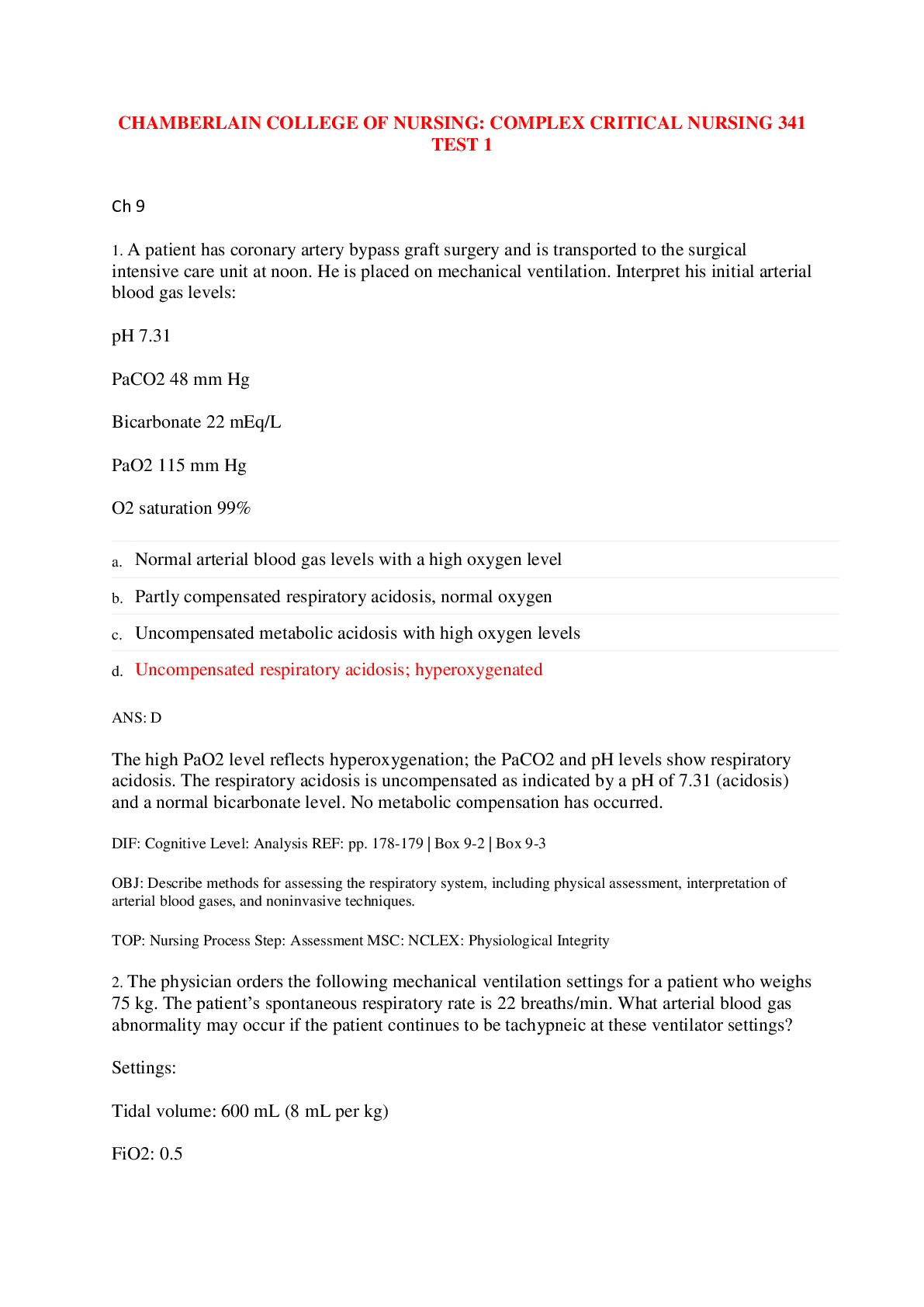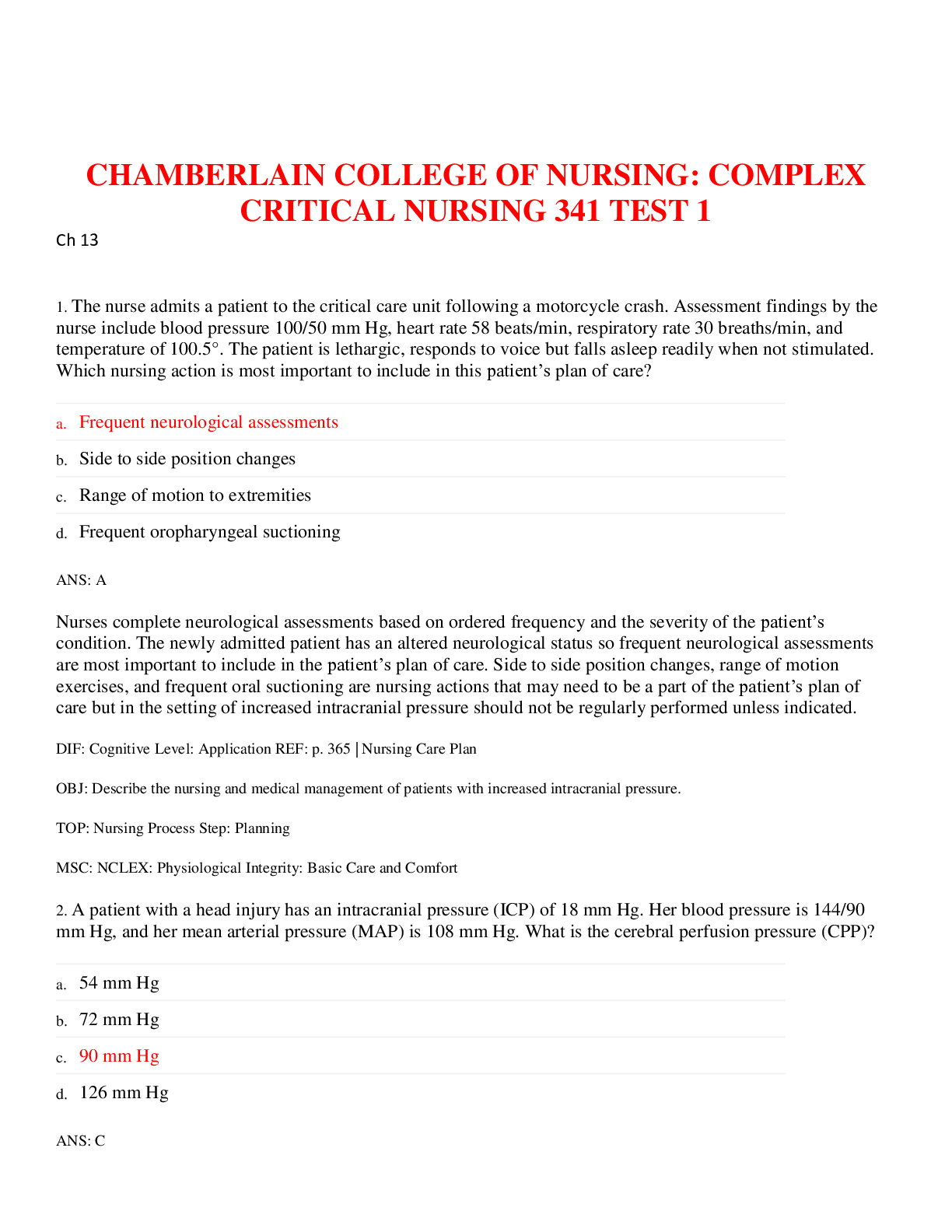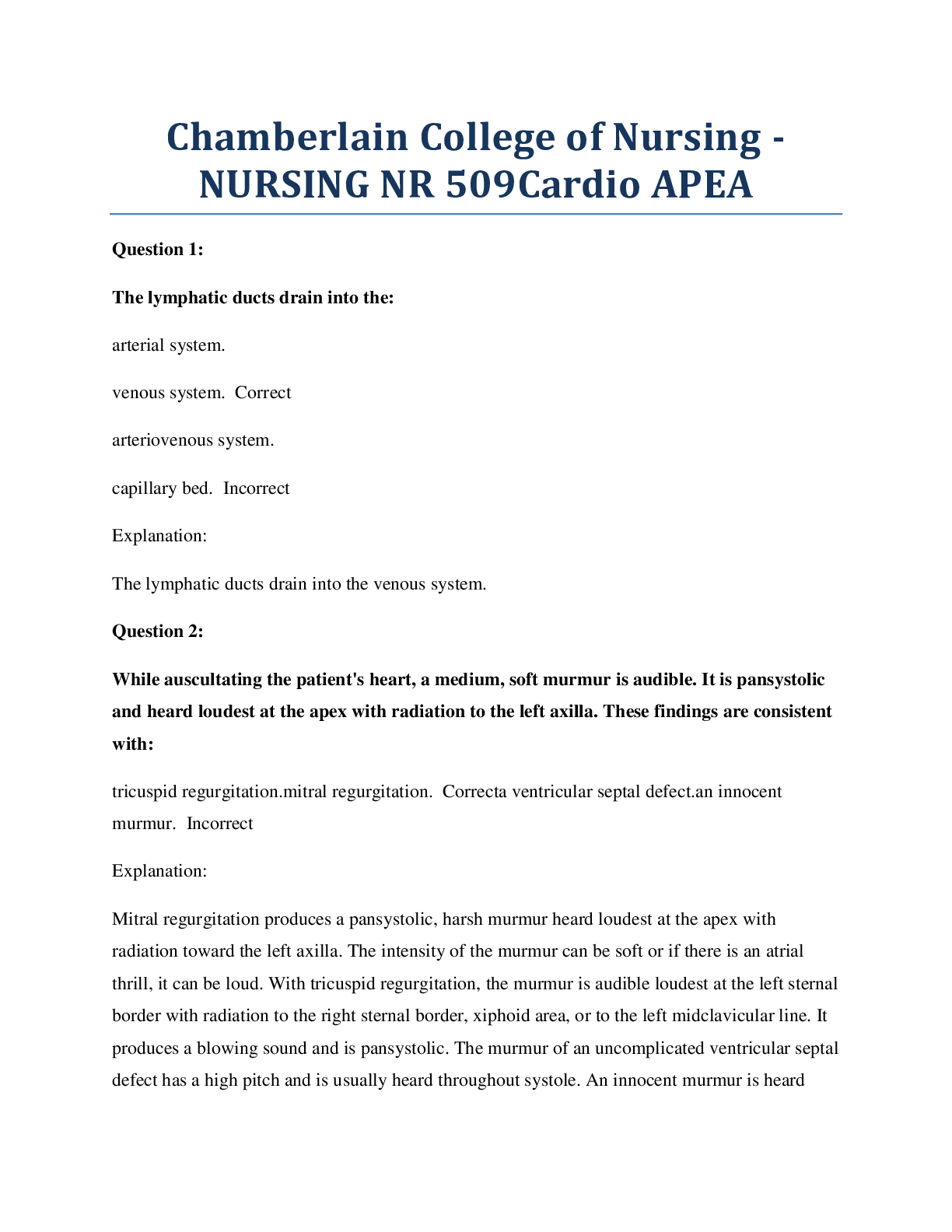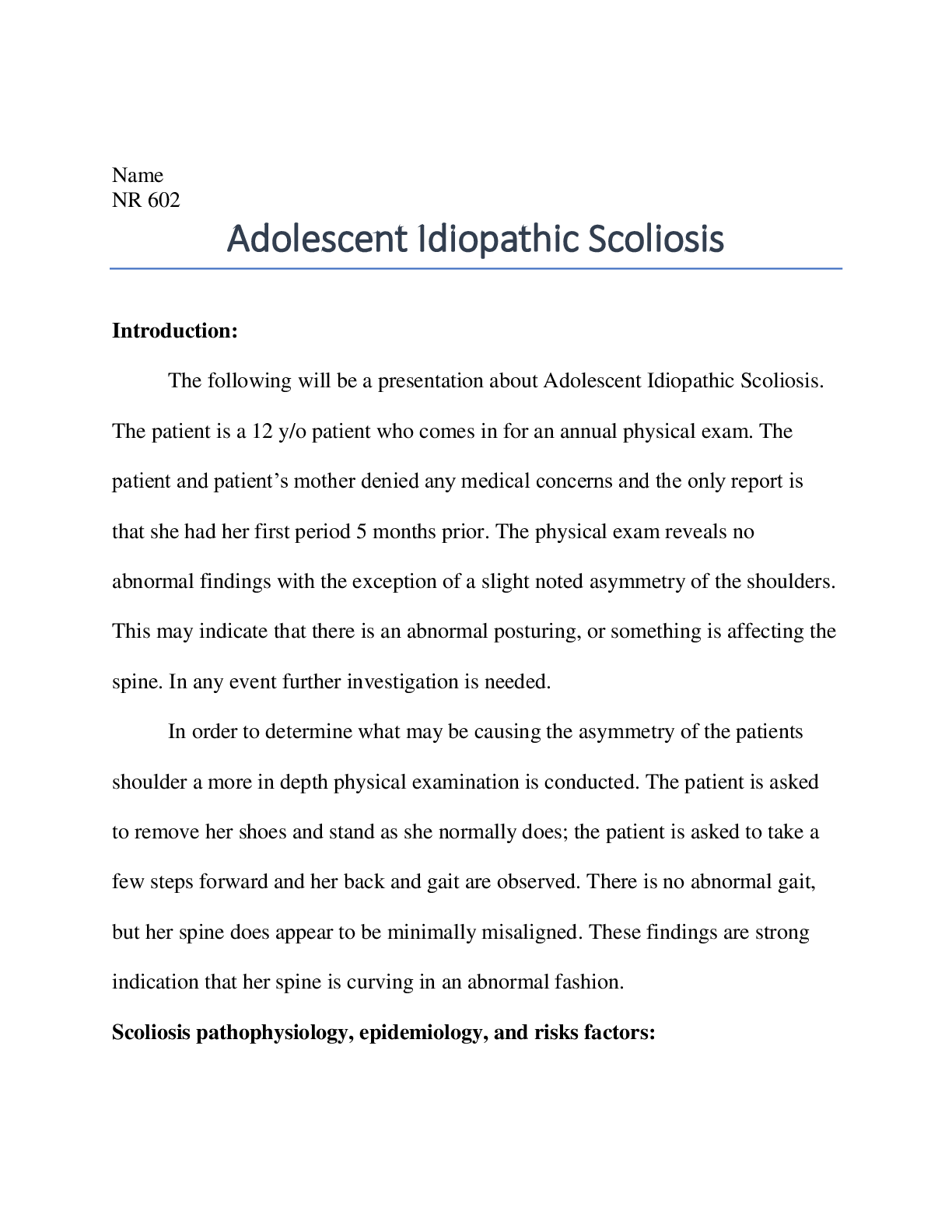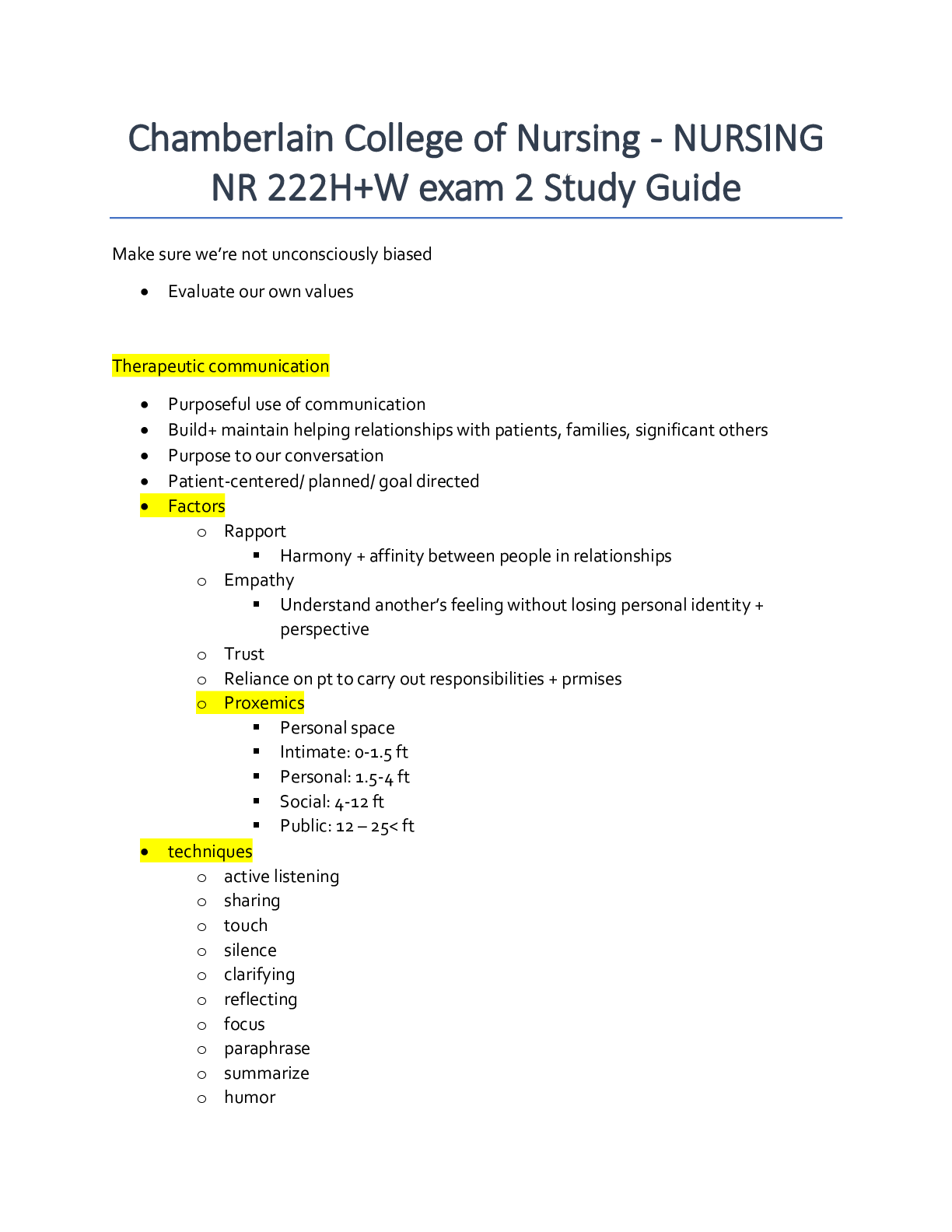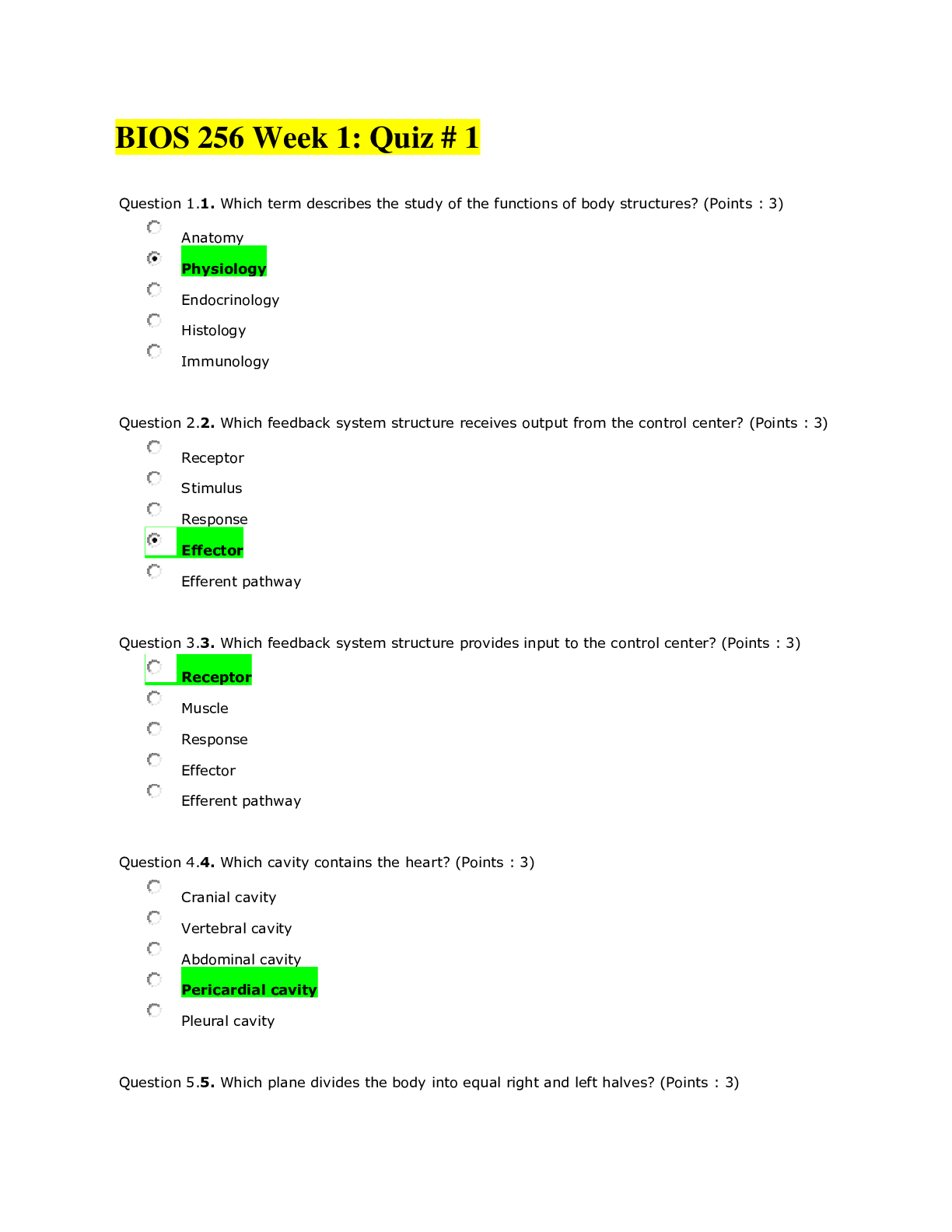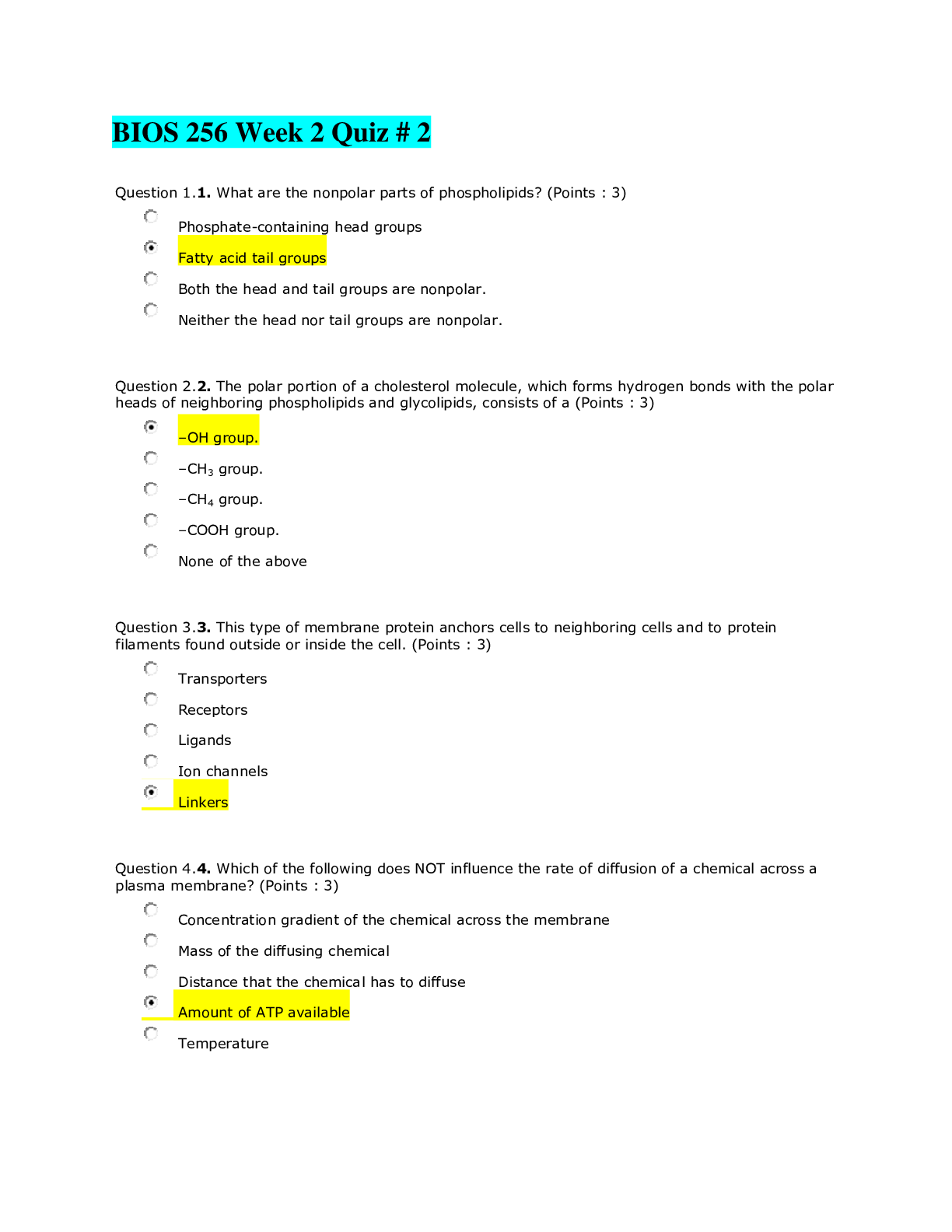Health Care > QUESTIONS & ANSWERS > ATI Care of the Patient Experiencing Shock or Heart Failure, Chapter 6: Perrin: Understanding the Es (All)
ATI Care of the Patient Experiencing Shock or Heart Failure, Chapter 6: Perrin: Understanding the Essentials of Critical Care Nursing: Chamberlain College of Nursing NR 341 (A Graded) Latest Questions and Complete Solutions
Document Content and Description Below
ATI Care of the Patient Experiencing Shock or Heart Failure, Chapter 6: Perrin: Understanding the Essentials of Critical Care Nursing: Chamberlain College of Nursing NR 341 (A Graded) Latest Questions... and Complete Solutions Perrin: Understanding the Essentials of Critical Care Nursing Chapter 6: Care of the Patient Experiencing Shock or Heart Failure MULTIPLE CHOICE. Choose the one alternative that best completes the statement or answers the questions 1) Which of the following should the nurse identify as symptoms of hypovolemic shock? (Select all that apply.) A) A temperature of 97.6°F (36.4°C) B) A decrease in blood pressure of 20 mm Hg when the patient sits up C) Capillary refill time greater than 3 seconds D) Restlessness E) Sinus bradycardia of 55 beats per minute Answer: B, C, D Explanation: A) (Note: This requires multiple responses to be correct.) Due to decreased blood flow to the brain and peripheral areas when blood is shunted to maintain the vital organs, cerebral hypoxia occurs. The action of standing will decrease the blood to the brain by gravitational pull and will require increased peripheral resistance or cardiac output to maintain cerebral blood supply. #1 is incorrect. Fever wil increase oxygen demands but is unrelated to hypovolemic shock unless prolonged fever has caused severe dehydration, reducing the circulating blood volume. Hypovolemic shock reduces temperatures by peripheral shunting of blood away from the extremities and reducing the core metabolic rate. If septic shock is present fever might be present, but it is not present in all patients with hypovolemic shock. #5 is incorrect. Bradycardia not present. The compensatory response is to increase the heart rate (tachycardia) to circulate the blood faster to make up for the fluids that are not present in hypovolemic shock. Nursing Process: Assessment Cognitive Level: Application Category of Need: Physiological Integrity–Physiological Adaptations B) (Note: This requires multiple responses to be correct.) Due to decreased blood flow to the brain and peripheral areas when blood is shunted to maintain the vital organs, cerebral hypoxia occurs. The action of standing will decrease the blood to the brain by gravitational pull and will require increased peripheral resistance or cardiac output to maintain cerebral blood supply. #1 is incorrect. Fever wil increase oxygen demands but is unrelated to hypovolemic shock unless prolonged fever has caused severe dehydration, reducing the circulating blood volume. Hypovolemic shock reduces temperatures by peripheral shunting of blood away from the extremities and reducing the core metabolic rate. If septic shock is present fever might be present, but it is not present in all patients with hypovolemic shock. #5 is incorrect. Bradycardia not present. The compensatory response is to increase the heart rate (tachycardia) to circulate the blood faster to make up for the fluids that are not present in hypovolemic shock. Nursing Process: Assessment Cognitive Level: Application Category of Need: Physiological Integrity–Physiological Adaptations C) (Note: This requires multiple responses to be correct.) Due to decreased blood flow to the brain and peripheral areas when blood is shunted to maintain the vital organs, cerebral hypoxia occurs. The action of standing will decrease the blood to the brain by gravitational pull and will require increased peripheral resistance or cardiac output to maintain cerebral blood supply. #1 is incorrect. Fever wil increase oxygen demands but is unrelated to hypovolemic shock unless prolonged fever has caused severe dehydration, reducing the circulating blood volume. Hypovolemic shock reduces temperatures by peripheral shunting of blood away from the extremities and reducing the core metabolic rate. If septic shock is present fever might be present, but it is not present in all patients with hypovolemic shock. #5 is incorrect. Bradycardia not present. The compensatory response is to increase the heart rate (tachycardia) to circulate the blood faster to make up for the fluids that are not present in hypovolemic shock. Nursing Process: Assessment Cognitive Level: Application Category of Need: Physiological Integrity–Physiological Adaptations D) (Note: This requires multiple responses to be correct.) Due to decreased blood flow to the brain and peripheral areas when blood is shunted to maintain the vital organs, cerebral hypoxia occurs. The action of standing will decrease the blood to the brain by gravitational pull and will require increased peripheral resistance or cardiac output to maintain cerebral blood supply. #1 is incorrect. Fever wil increase oxygen demands but is unrelated to hypovolemic shock unless prolonged fever has caused severe dehydration, reducing the circulating blood volume. Hypovolemic shock reduces temperatures by peripheral shunting of blood away from the extremities and reducing the core metabolic rate. If septic shock is present fever might be present, but it is not present in all patients with hypovolemic shock. #5 is incorrect. Bradycardia not present. The compensatory response is to increase the heart rate (tachycardia) to circulate the blood faster to make up for the fluids that are not present in hypovolemic shock. Nursing Process: Assessment Cognitive Level: Application Category of Need: Physiological Integrity–Physiological Adaptations E) (Note: This requires multiple responses to be correct.) Due to decreased blood flow to the brain and peripheral areas when blood is shunted to maintain the vital organs, cerebral hypoxia occurs. The action of standing will decrease the blood to the brain by gravitational pull and will require increased peripheral resistance or cardiac output to maintain cerebral blood supply. #1 is incorrect. Fever wil increase oxygen demands but is unrelated to hypovolemic shock unless prolonged fever has caused severe dehydration, reducing the circulating blood volume. Hypovolemic shock reduces temperatures by peripheral shunting of blood away from the extremities and reducing the core metabolic rate. If septic shock is present fever might be present, but it is not present in all patients with hypovolemic shock. #5 is incorrect. Bradycardia not present. The compensatory response is to increase the heart rate (tachycardia) to circulate the blood faster to make up for the fluids that are not present in hypovolemic shock. Nursing Process: Assessment Cognitive Level: Application Category of Need: Physiological Integrity–Physiological Adaptations 2) Which of the following lab findings should cause the nurse to suspect that a patient was developing hypovolemic shock? A) Serum sodium of 130 mEq/L (130 mmol/L) B) Metabolic alkalosis validated by arterial blood gases C) Serum lactate of 5 mmol/L D) SvO2 greater than 80% Answer: B Explanation: A) Metabolic acidosis is present due to an accumulation of carbonic acid, leaving a bicarbonate deficit from decreased tissue perfusion. #1 is incorrect. The sodium level in hypovolemic shock is elevated above the normal values of 135 to 145 mEq/L, not depressed. The increased concentration of sodium occurs when the circulating volume is decreased, concentrating the elements. #3 is incorrect. Serum lactate is greater than 4 mmol/L as a result of tissue ischemia, hypoxia, and breakdown from decreased blood flow with hypovolemic shock. Normal lactate levels are 0.3 to 2.6 mmol/L. #4 is incorrec SvO2 (mixed venous oxygen saturation) would be less than 60% due to decreased circulating blood volume or decrease in cells to carry the oxygen. There2foirse, O carried less efficiently and decreased, not increased. The normal values f2orarSevO between 60% and 80%. Nursing Process: Evaluation Cognitive Level: Analysis Category of Need: Physiological Integrity–Reduction of Risk Potential B) Metabolic acidosis is present due to an accumulation of carbonic acid, leaving a bicarbonate deficit from decreased tissue perfusion. #1 is incorrect. The sodium level in hypovolemic shock is elevated above the normal values of 135 to 145 mEq/L, not depressed. The increased concentration of sodium occurs when the circulating volume is decreased, concentrating the elements. #3 is incorrect. Serum lactate is greater than 4 mmol/L as a result of tissue ischemia, hypoxia, and breakdown from decreased blood flow with hypovolemic shock. Normal lactate levels are 0.3 to 2.6 mmol/L. #4 is incorrec SvO2 (mixed venous oxygen saturation) would be less than 60% due to decreased circulating blood volume or decrease in cells to carry the oxygen. There2foirse, O carried less efficiently and decreased, not increased. The normal values f2orarSevO between 60% and 80%. Nursing Process: Evaluation Cognitive Level: Analysis Category of Need: Physiological Integrity–Reduction of Risk Potential C) Metabolic acidosis is present due to an accumulation of carbonic acid, leaving a bicarbonate deficit from decreased tissue perfusion. #1 is incorrect. The sodium level in hypovolemic shock is elevated above the normal values of 135 to 145 mEq/L, not depressed. The increased concentration of sodium occurs when the circulating volume is decreased, concentrating the elements. #3 is incorrect. Serum lactate is greater than 4 mmol/L as a result of tissue ischemia, hypoxia, and breakdown from decreased blood flow with hypovolemic shock. Normal lactate levels are 0.3 to 2.6 mmol/L. #4 is incorrec SvO2 (mixed venous oxygen saturation) would be less than 60% due to decreased circulating blood volume or decrease in cells to carry the oxygen. There2foirse, O carried less efficiently and decreased, not increased. The normal values f2orarSevO between 60% and 80%. Nursing Process: Evaluation Cognitive Level: Analysis Category of Need: Physiological Integrity–Reduction of Risk Potential D) Metabolic acidosis is present due to an accumulation of carbonic acid, leaving a bicarbonate deficit from decreased tissue perfusion. #1 is incorrect. The sodium level in hypovolemic shock is elevated above the normal values of 135 to 145 mEq/L, not depressed. The increased concentration of sodium occurs when the circulating volume is decreased, concentrating the elements. #3 is incorrect. Serum lactate is greater than 4 mmol/L as a result of tissue ischemia, hypoxia, and breakdown from decreased blood flow with hypovolemic shock. Normal lactate levels are 0.3 to 2.6 mmol/L. #4 is incorrec SvO2 (mixed venous oxygen saturation) would be less than 60% due to decreased circulating blood volume or decrease in cells to carry the oxygen. There2foirse, O carried less efficiently and decreased, not increased. The normal values f2orarSevO between 60% and 80%. Nursing Process: Evaluation Cognitive Level: Analysis Category of Need: Physiological Integrity–Reduction of Risk Potential [Show More]
Last updated: 1 year ago
Preview 1 out of 39 pages

Buy this document to get the full access instantly
Instant Download Access after purchase
Add to cartInstant download
We Accept:

Reviews( 0 )
$15.50
Document information
Connected school, study & course
About the document
Uploaded On
May 24, 2021
Number of pages
39
Written in
Additional information
This document has been written for:
Uploaded
May 24, 2021
Downloads
0
Views
45

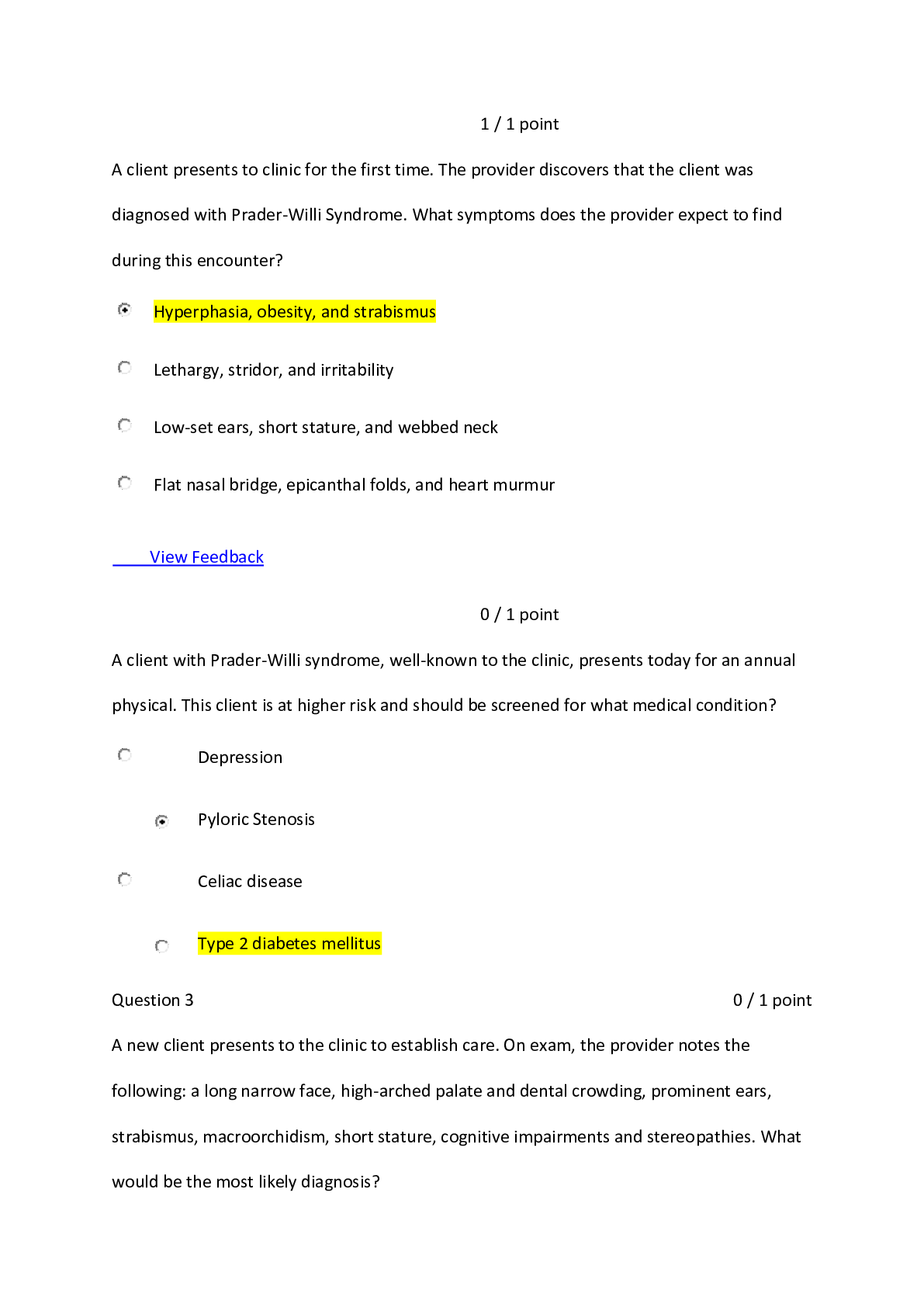
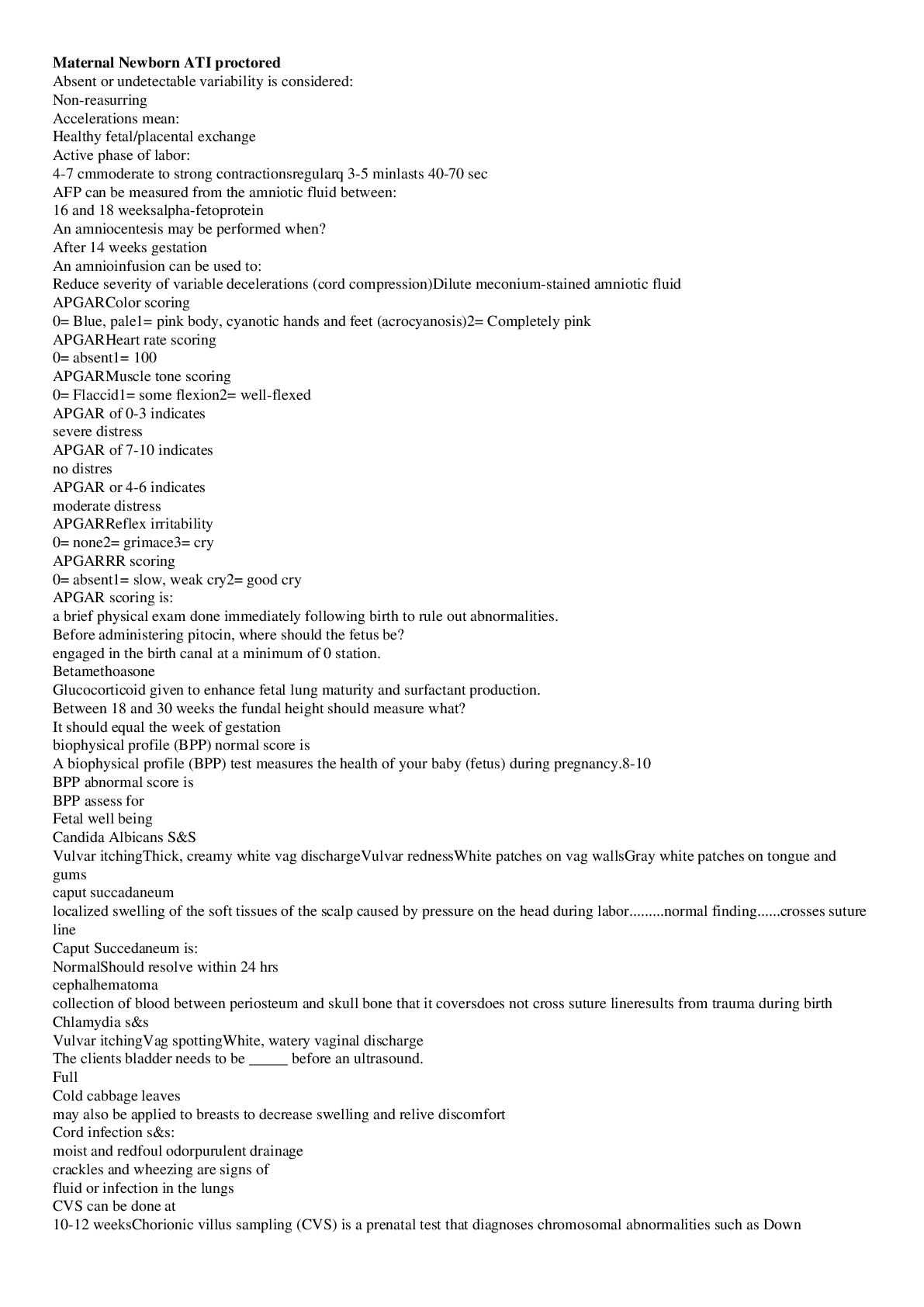
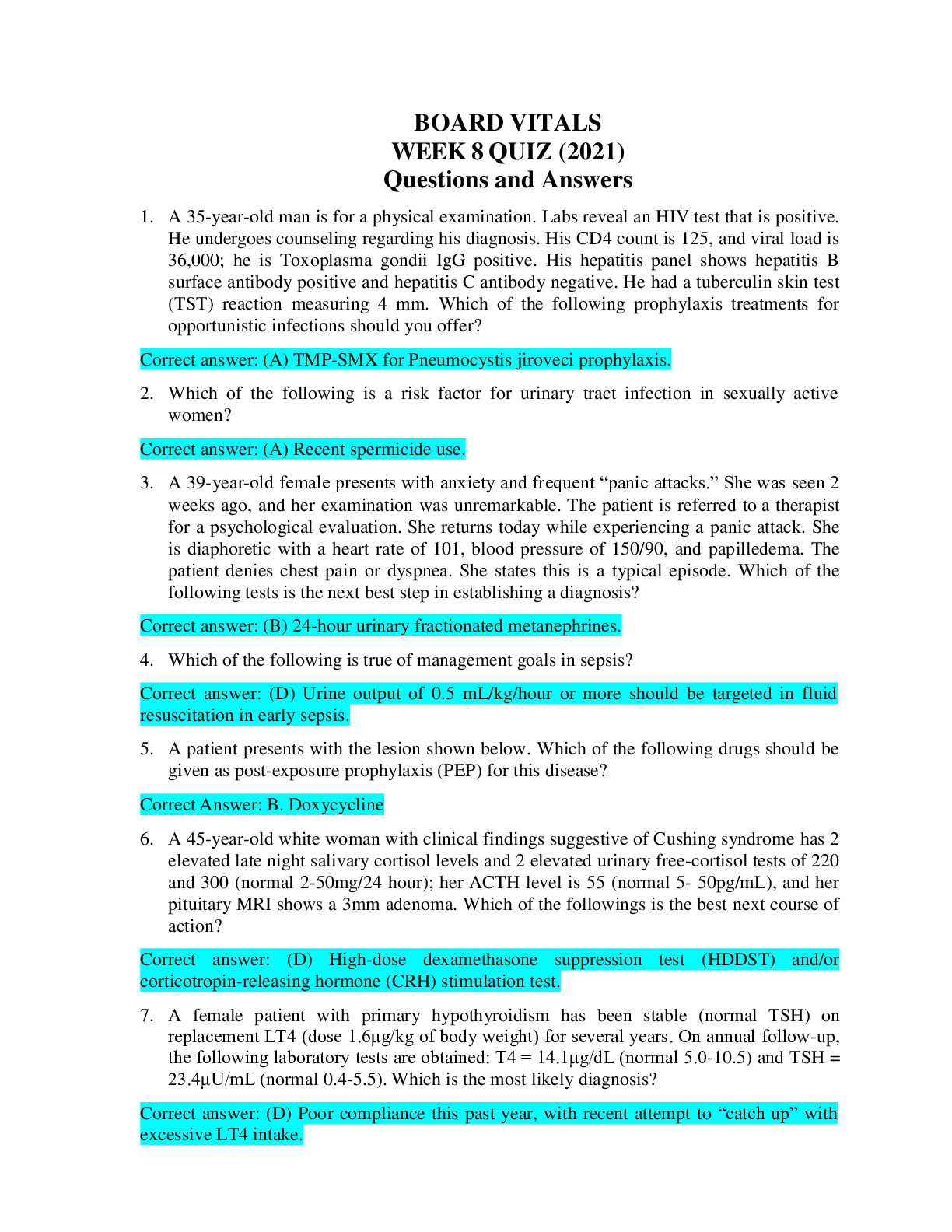

, (A Grade), Questions and Answers, All Correct Study Guide, Download to Score A.png)
, Questions and Answers, All Correct Study Guide, Download to Score A.png)
, Latest Questions and Answers with Explanations, All Correct Study Guide, Download to Score A.png)
, Latest Questions and Answers with Explanations, All Correct Study Guide, Download to Score A.png)
, Latest Questions and Answers with Explanations, All Correct Study Guide, Download to Score A.png)
, Latest Questions and Answers with Explanations, All Correct Study Guide, Download to Score A.png)
 (Verified Answers, COMPLETE GUIDE FOR EXAM PREPARATION).png)
 All Correct Answers, Download to Score A.png)
